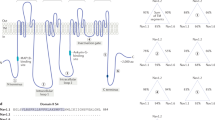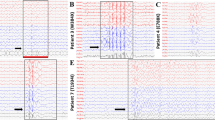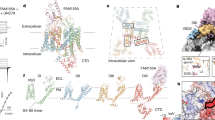Abstract
What is the relationship between sodium channel function, neuronal function and clinical status in channelopathies of the nervous system? Given the central role of sodium channels in the generation of neuronal activity, channelopathies involving sodium channels might be expected to cause either enhanced sodium channel function and neuronal hyperexcitability associated with positive clinical manifestations such as seizures, or attenuated channel function and neuronal hypoexcitability associated with negative clinical manifestations such as paralysis. In this article, I review observations showing that changes in neuronal function and clinical status associated with channelopathies are not necessarily predictable solely from the altered physiological properties of the mutated channel itself. I discuss evidence showing that cell background acts as a filter that can strongly influence the effects of ion channel mutations.
This is a preview of subscription content, access via your institution
Access options
Subscribe to this journal
Receive 12 print issues and online access
$209.00 per year
only $17.42 per issue
Buy this article
- Purchase on Springer Link
- Instant access to full article PDF
Prices may be subject to local taxes which are calculated during checkout




Similar content being viewed by others
Change history
25 May 2007
pub date
References
George, A.L., Jr. Inherited channelopathies associated with epilepsy. Epilepsy Curr. 4, 65–70 (2004).
Cannon, S.C. Pathomechanisms in channelopathies of skeletal muscle and brain. Annu. Rev. Neurosci. 29, 387–415 (2006).
Hughlings Jackson, J. Selected Writings (ed. Taylor, T.) (Hodder and Stoughton, London, 1931).
Adrian, E.D. The activity of the nerve fibres. Nobel Prize Lecture in Physiology or Medicine, 1922–1941 (Elsevier Publishing, Amsterdam, 1965).
Hodgkin, A.L. & Huxley, A.F. A quantitative description of membrane current and its application to conduction and excitation in nerve. J. Physiol. (Lond.) 117, 500–544 (1952).
Escayg, A. et al. Mutations of SCN1A, encoding a neuronal sodium channel, in two families with GEFS+2. Nat. Genet. 24, 343–345 (2000).
Kearney, J.A. et al. A gain-of-function mutation in the sodium channel gene Scn2a results in seizures and behavioral abnormalities. Neuroscience 102, 307–317 (2001).
Lossin, C. et al. Molecular basis of an inherited epilepsy. Neuron 34, 877–884 (2002).
Fujiwara, T. et al. Mutations of sodium channel α type 1 (SCN1A) in intractable childhood epilepsies with frequent generalized tonic-clonic seizures. Brain 126, 531–546 (2003).
Kamiya, K. et al. A nonsense mutation of the sodium channel gene SCN2A in a patient with intractable epilepsy and mental decline. J. Neurosci. 24, 2690–2698 (2004).
Claes, L. et al. De novo mutations in the sodium-channel gene SCN1A cause severe myoclonic epilepsy of infancy. Am. J. Hum. Genet. 68, 1327–1332 (2001).
Lossin, C. et al. Epilepsy-associated dysfunction in the voltage-gated neuronal sodium channel SCN1A. J. Neurosci. 23, 11289–11295 (2003).
Meisler, M.H. & Kearney, J.A. Sodium channel mutations in epilepsy and other neurological disorders. J. Clin. Invest. 115, 2010–2017 (2005).
Barela, A.J. et al. An epilepsy mutation in the sodium channel SCN1A that decreases channel excitability. J. Neurosci. 26, 2714–2723 (2006).
Mulley, J.C. et al. A new molecular mechanism for severe myoclonic epilepsy of infancy: exonic deletions in SCN1A. Neurology 67, 1094–1095 (2006).
Bergren, S.K. et al. Genetic modifiers affecting severity of epilepsy caused by mutation of sodium channel Scn2a. Mamm. Genome 16, 683–690 (2005).
Yu, F.H. et al. Reduced sodium current in GABAergic interneurons in a mouse model of severe myoclonic epilepsy in infancy. Nat. Neurosci. 9, 1142–1149 (2006).
Cummins, T.R. et al. Nav1.3 sodium channels: rapid repriming and slow closed-state inactivation display quantitative differences after expression in a mammalian cell line and in spinal sensory neurons. J. Neurosci. 21, 5952–5961 (2001).
Waxman, S.G. & Dib-Hajj, S.D. Erythermalgia: molecular basis for an inherited pain syndrome. Trends Mol. Med. 11, 555–562 (2005).
Cummins, T.R., Howe, J.R. & Waxman, S.G. Slow closed-state inactivation: a novel mechanism underlying ramp currents in cells expressing the hNE/PN1 sodium channel. J. Neurosci. 18, 9606–9619 (1998).
Toledo-Aral, J.J. et al. Identification of PN1, a predominant voltage-dependent sodium channel expressed principally in peripheral neurons. Proc. Natl. Acad. Sci. USA 94, 1527–1532 (1997).
Nassar, M.A. et al. Nociceptor-specific gene deletion reveals a major role for Nav1.7 (PN1) in acute and inflammatory pain. Proc. Natl. Acad. Sci. USA 101, 12706–12711 (2004).
Cox, J.J. et al. An SCN9A channelopathy causes congenital inability to experience pain. Nature 444, 894–898 (2006).
Dib-Hajj, S.D. et al. Gain-of-function mutation in Nav1.7 in familial erythromelalgia induces bursting of sensory neurons. Brain 128, 1847–1854 (2005).
Davis, M.D. et al. Erythromelalgia: vasculopathy, neuropathy, or both? A prospective study of vascular and neurophysiologic studies in erythromelalgia. Arch. Dermatol. 139, 1337–1343 (2003).
Mork, C., Kalgaard, O.M. & Kvernebo, K. Impaired neurogenic control of skin perfusion in erythromelalgia. J. Invest. Dermatol. 118, 699–703 (2002).
Yang, Y. et al. Mutations in SCN9A, encoding a sodium channel α subunit, in patients with primary erythermalgia. J. Med. Genet. 41, 171–174 (2004).
Cummins, T.R., Dib-Hajj, S.D. & Waxman, S.G. Electrophysiological properties of mutant Nav1.7 sodium channels in a painful inherited neuropathy. J. Neurosci. 24, 8232–8236 (2004).
Rush, A.M. et al. A single sodium channel mutation produces hyper- or hypoexcitability in different types of neurons. Proc. Natl. Acad. Sci. USA 103, 8245–8250 (2006).
Akopian, A.N., Sivilotti, L. & Wood, J.N. A tetrodotoxin-resistant voltage-gated sodium channel expressed by sensory neurons. Nature 379, 257–262 (1996).
Sangameswaran, L. et al. Structure and function of a novel voltage-gated, tetrodotoxin-resistant sodium channel specific to sensory neurons. J. Biol. Chem. 271, 5953–5956 (1996).
Catterall, W.A., Goldin, A.L. & Waxman, S.G. International Union of Pharmacology. XLVII. Nomenclature and structure-function relationships of voltage-gated sodium channels. Pharmacol. Rev. 57, 397–409 (2005).
Cummins, T.R. & Waxman, S.G. Down-regulation of tetrodotoxin-resistant sodium currents and up-regulation of a rapidly repriming tetrodotoxin-sensitive sodium current in small spinal sensory neurons following nerve injury. J. Neurosci. 17, 3503–3514 (1997).
Renganathan, M., Cummins, T.R. & Waxman, S.G. Contribution of Nav1.8 sodium channels to action potential electrogenesis in DRG neurons. J. Neurophysiol. 86, 629–640 (2001).
Blair, N.T. & Bean, B.P. Roles of tetrodotoxin (TTX)-sensitive Na+ current, TTX-resistant Na+ current and Ca2+ current in the action potentials of nociceptive sensory neurons. J. Neurosci. 22, 10277–10290 (2002).
Spampanato, J. et al. A novel epilepsy mutation in the sodium channel SCN1A identifies a cytoplasmic domain for β subunit interaction. J. Neurosci. 3, 10022–10034) (2004).
Grieco, T.M., Malhotra, J.D., Chen, C., Isom, L.L. & Raman, I.M. Open-channel block by the cytoplasmic tail of sodium channel β4 as a mechanism for resurgent sodium current. Neuron 45, 233–244 (2005).
Wittmack, E.K. et al. Fibroblast growth factor homologous factor 2B: association with Nav1.6 and selective colocalization at nodes of Ranvier in dorsal root axons. J. Neurosci. 24, 6765–6775 (2004).
Djouhri, L. et al. The TTX-resistant sodium channel Nav1.8 (SNS/PN3): expression and correlation with membrane properties in rat nociceptive primary afferent neurons. J. Physiol. (Lond.) 550, 739–752 (2003).
Porreca, F. et al. A comparison of the potential role of the tetrodotoxin-insensitive sodium channels, PN3/SNS and NaN/SNS2, in rat models of chronic pain. Proc. Natl. Acad. Sci. USA 96, 7640–7644 (1999).
Djouhri, L. et al. Sensory and electrophysiological properties of guinea-pig sensory neurons expressing Nav1.7 (PN1) Na+ channel α subunit protein. J. Physiol. (Lond.) 546, 565–576 (2003).
Renganathan, M., Cummins, T.R., Hormuzdiar, W.N. & Waxman, S.G. Alpha-SNS produces the slow TTX-resistant sodium current in large cutaneous afferent DRG neurons. J. Neurophysiol. 84, 710–720 (2000).
Stys, P.K., Waxman, S.G. & Ransom, B.R. Ionic mechanisms of anoxic injury in mammalian CNS white matter: role of Na+ channels and Na+-Ca2+ exchanger. J. Neurosci. 12, 430–439 (1992).
Black, J.A., Liu, S., Tanaka, M., Cummins, T.R. & Waxman, S.G. Changes in the expression of tetrodotoxin-sensitive sodium channels within dorsal root ganglia neurons in inflammatory pain. Pain 108, 237–247 (2004).
Black, J.A. et al. Sensory neuron specific sodium channel SNS is abnormally expressed in the brains of mice with experimental allergic encephalomyelitis and humans with multiple sclerosis. Proc. Natl. Acad. Sci. USA 97, 11598–11602 (2000).
Dib-Hajj, S.D. et al. Rescue of α-SNS sodium channel expression in small dorsal root ganglion neurons after axotomy by nerve growth factor in vivo. J. Neurophysiol. 79, 2668–2676 (1998).
De Simone, R., Micera, A., Tirassa, P. & Aloe, L. mRNA for NGF and p75 in the central nervous system of rats affected by experimental allergic encephalomyelitis. Neuropathol. Appl. Neurobiol. 22, 54–59 (1996).
Damarjian, T.G., Craner, M.J., Black, J.A. & Waxman, S.G. Upregulation and colocalization of p75 and Nav1.8 in Purkinje neurons in experimental autoimmune encephalomyelitis. Neurosci. Lett. 369, 186–190 (2004).
Renganathan, M., Gelderblom, M., Black, J.A. & Waxman, S.G. Expression of Nav1.8 sodium channels perturbs the firing patterns of cerebellar Purkinje cells. Brain Res. 959, 235–243 (2003).
Saab, C.Y., Craner, M.J., Kataoka, Y. & Waxman, S.G. Abnormal Purkinje cell activity in vivo in experimental allergic encephalomyelitis. Exp. Brain Res. 158, 1–8 (2004).
Author information
Authors and Affiliations
Ethics declarations
Competing interests
The author declares no competing financial interests.
Rights and permissions
About this article
Cite this article
Waxman, S. Channel, neuronal and clinical function in sodium channelopathies: from genotype to phenotype. Nat Neurosci 10, 405–409 (2007). https://doi.org/10.1038/nn1857
Published:
Issue Date:
DOI: https://doi.org/10.1038/nn1857
This article is cited by
-
The influence of sodium on pathophysiology of multiple sclerosis
Neurological Sciences (2017)
-
Lack of transient receptor potential vanilloid 1 channel modulates the development of neurogenic bladder dysfunction induced by cross-sensitization in afferent pathways
Journal of Neuroinflammation (2013)
-
Natural and artificial ion channels for biosensing platforms
Analytical and Bioanalytical Chemistry (2012)
-
Ion channels and schizophrenia: a gene set-based analytic approach to GWAS data for biological hypothesis testing
Human Genetics (2012)
-
Effects of Ranolazine on Wild-Type and Mutant hNav1.7 Channels and on DRG Neuron Excitability
Molecular Pain (2010)



